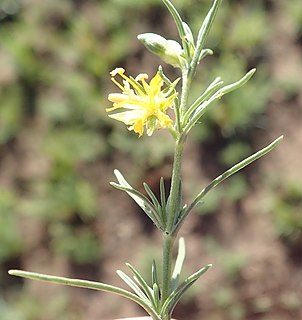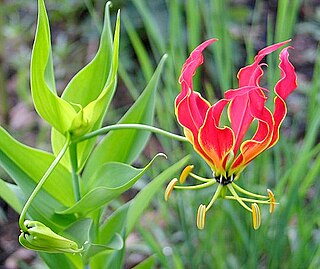
The economy of Zimbabwe is mainly made of tertiary industry, which makes up to 60% of the total GDP as of 2017. Zimbabwe has the second biggest informal economy as a share of its economy which has a score of 60.6%. Agriculture and mining largely contribute to exports. The economy of Zimbabwe grew at an average of 12% from 2009 to 2013, rendering it one of the fastest growing economies in the world recovering from negative growth from 1998 to 2008 before it slowed to 0.7% growth in 2016.

Bulawayo is the second largest city in Zimbabwe, and the largest city in the country's Matabeleland region. The city's population is disputed; the 2012 census listed it at 653,337, while the Bulawayo City Council claimed it to be about 1.2 million. Bulawayo covers an area of about 1,707 square kilometres in the western part of the country, along the Matsheumhlope River. Along with the capital Harare, Bulawayo is one of two cities in Zimbabwe that is also a province.

Hoodia is a genus of flowering plants in the family Apocynaceae, under the subfamily Asclepiadoideae, native to Southern Africa.

Colophospermum mopane, commonly called mopane, mopani, balsam tree, butterfly tree, or turpentine tree, is a tree in the legume family (Fabaceae), that grows in hot, dry, low-lying areas, 200 to 1,150 metres in elevation, in the far northern parts of southern Africa. The tree only occurs in Africa and is the only species in genus Colophospermum. Its distinctive butterfly-shaped (bifoliate) leaf and thin seed pod make it easy to identify. In terms of human use it is, together with camel thorn and leadwood, one of the three regionally important firewood trees.

Synsepalum is a genus of trees and shrubs in the chicle family, Sapotaceae described as a genus in 1852.

The wildlife of Zimbabwe occurs foremost in remote or rugged terrain, in national parks and private wildlife ranches, in miombo woodlands and thorny acacia or kopje. The prominent wild fauna includes African buffalo, African bush elephant, black rhinoceros, southern giraffe, African leopard, lion, plains zebra, and several antelope species.

Blueberries are perennial flowering plants with blue or purple berries. They are classified in the section Cyanococcus within the genus Vaccinium. Vaccinium also includes cranberries, bilberries, huckleberries and Madeira blueberries. Commercial blueberries—both wild (lowbush) and cultivated (highbush)—are all native to North America. The highbush varieties were introduced into Europe during the 1930s.

Vahlia is a genus of herbs and subshrubs that grow in Africa and the Indian subcontinent. There are at least five species.
Droogmansia is a genus of flowering plants in the legume family, Fabaceae. It belongs to the subfamily Faboideae.
National Botanic Garden of Zimbabwe is situated about 4 km North of Harare City Centre in the suburb of Alexandra Park. It also houses the National Herbarium of Zimbabwe. The gardens have an area of almost 7 square kilometres. It was initially established as a recreation area in 1902. In 1962 it became the National Botanic Gardens under the direction of Prof. Hiram Wild. Half of the gardens are devoted to indigenous plants from Zimbabwe's woodlands and include most of the 750 species found in the country. Other areas contain plants typical to the African continent including rare and endangered species, as well as exotics from South America, India, Australia and the Far East. It contains 90% of the different ecological habitats in found in Zimbabwe.

Capparis fascicularis, the zigzag caper-bush, is a plant in the Capparaceae family and is native to Africa.

Protea roupelliae is a species of Protea in the large family Proteaceae, and was named to commemorate Arabella Elizabeth Roupell (1817-1914) who spent two years in Cape Town and painted local flowers for her own pleasure.
The Mohamed Bin Zayed Species Conservation Fund is an endowment that promotes species conservation worldwide headed by Mohammed bin Zayed Al Nahyan, the crown prince of Abu Dhabi. The fund was established in October 2008 and became active in January 2009. It had an initial endowment of €25 million. Proceeds from the endowment are directed to projects to conserve threatened and endangered species of animals, plants and fungi around the world. It gave more than $2.4m in 2010 to 214 projects in almost 80 countries. From 2009 to summer 2019, the MBZ Fund has supported 1,982 projects with $18.5 million dollars across more than 150 countries.

Gloriosa superba is a species of flowering plant in the family Colchicaceae. Common names include flame lily, climbing lily, creeping lily, glory lily, gloriosa lily, tiger claw, and fire lily.

Tatenda Marshal Mkuruva is a Zimbabwean international footballer who plays as a goalkeeper for National Independent Soccer Association club Michigan Stars FC and the Zimbabwe national team.
Vachellia kirkii, widely known as Acacia kirkii but now attributed to the genus Vachellia, is a tree native to tropical Africa. It is commonly known as the flood plain acacia.
Protea asymmetrica, also known as the Inyanga sugarbush, is a flowering plant, named for its asymmetric flowerheads, of the family Proteaceae and endemic to Zimbabwe and the Nyanga region, where it grows in grasslands, as well as Mount Nyangani.
Protea dracomontana, the Nyanga protea or the Drakensberg sugarbush, is a flowering plant that belongs within the genus Protea. The plant is found in the Eastern Cape, Lesotho, KwaZulu-Natal and the escarpment of the Free State, as well as eastern Zimbabwe. In Zimbabwe this species is only known from a disjunct subpopulation confined to the summit of Mount Nyangani.
Protea enervis, also known as the Chimanimani sugarbush, is a flowering shrub. It is native to the Chimanimani Mountains straddling Zimbabwe and Mozambique, and grows at altitudes of 1,680 to 2,000 metres.

Protea wentzeliana, also known as Wentzel's sugarbush, is a shrub belonging to the genus Protea.












